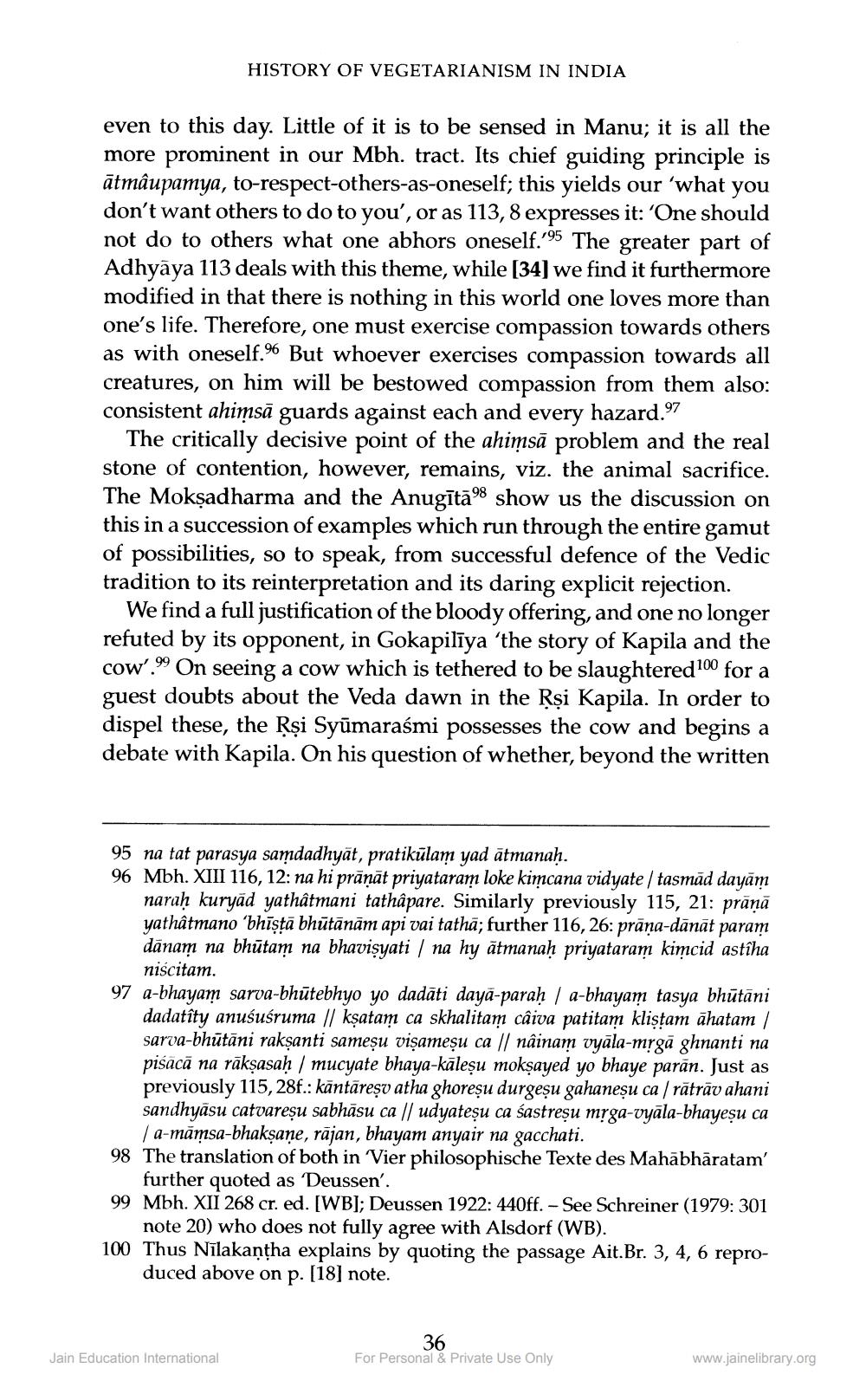________________
HISTORY OF VEGETARIANISM IN INDIA
even to this day. Little of it is to be sensed in Manu; it is all the more prominent in our Mbh. tract. Its chief guiding principle is ātmâupamya, to-respect-others-as-oneself; this yields our 'what you don't want others to do to you', or as 113,8 expresses it: 'One should not do to others what one abhors oneself.'95 The greater part of Adhyāya 113 deals with this theme, while [34] we find it furthermore modified in that there is nothing in this world one loves more than one's life. Therefore, one must exercise compassion towards others as with oneself.96 But whoever exercises compassion towards all creatures, on him will be bestowed compassion from them also: consistent ahimsā guards against each and every hazard.97
The critically decisive point of the ahimsā problem and the real stone of contention, however, remains, viz. the animal sacrifice. The Mokşadharma and the Anugītā98 show us the discussion on this in a succession of examples which run through the entire gamut of possibilities, so to speak, from successful defence of the Vedic tradition to its reinterpretation and its daring explicit rejection.
We find a full justification of the bloody offering, and one no longer refuted by its opponent, in Gokapilīya 'the story of Kapila and the cow'.99 On seeing a cow which is tethered to be slaughtered 100 for a guest doubts about the Veda dawn in the Rși Kapila. In order to dispel these, the Rși Syūmaraśmi possesses the cow and begins a debate with Kapila. On his question of whether, beyond the written
95 na tat parasya samdadhyāt, pratikülam yad ātmanah. 96 Mbh. XIII 116, 12: na hi prānāt priyataram loke kimcana vidyate / tasmăd dayām
naraḥ kuryad yathậtmani tathâpare. Similarly previously 115, 21: prāņā yathâtmano 'bhīstā bhūtānām api vai tathā; further 116, 26: prāna-dānāt param dānam na bhūtam na bhavisyati | na hy ātmanaḥ priyataram kimcid astîha
niscitam. 97 a-bhayam sarva-bhūtebhyo yo dadāti dayā-paraḥ | a-bhayam tasya bhūtāni
dadatîty anusuśruma || kşatam ca skhalitam câiva patitam klistam āhatam/ sarva-bhūtāni rakṣanti samesu visameșu ca // nainam vyāla-mrgā ghnanti na pisacā na rākşasah / mucyate bhaya-kāleșu mokşayed yo bhaye parān. Just as previously 115, 28f.: kāntāreşv atha ghoreșu durgeşu gahaneșu ca / rätrāv ahani sandhyāsu catvareșu sabhāsu ca // udyateṣu ca śastresu mrga-vyāla-bhayesu ca
| a-māmsa-bhakşaņe, rājan, bhayam anyair na gacchati. 98 The translation of both in Vier philosophische Texte des Mahabharatam'
further quoted as Deussen'. 99 Mbh. XII 268 cr. ed. (WB]; Deussen 1922: 440ff. - See Schreiner (1979: 301
note 20) who does not fully agree with Alsdorf (WB). 100 Thus Nīlakantha explains by quoting the passage Ait.Br. 3, 4, 6 repro
duced above on p. [18] note.
36 For Personal & Private Use Only
Jain Education International
www.jainelibrary.org




